Movie Review: Hitting the Apex
If you’re already a fan of grand prix motorcycle racing, Hitting the Apex will transport you from the stands inside the garages and beyond, occasionally into the living rooms of the riders themselves. Any sports documentary capable of doing that must be deemed a success.
In North America, grand prix motorcycle racing is a boutique sport, more popular than Scottish caber tossing but without the rabid following of, say, Australian Rules football. Pretty much everywhere else on the planet, MotoGP, the sport’s copyrighted street name, unleashes the passions of millions of men and women the way NASCAR used to in the U.S. Mark Neale’s latest documentary Hitting the Apex does for MotoGP what NFL films does for pro football: it brings you so close to the action and the riders that you feel virtually engulfed. And though there’s plenty of racing action, the film’s most powerful moments are its most quiet.
Narrated by co-producer Brad Pitt, the film’s title describes the process riders observe to maximize their speed in the turns, where the real action takes place. The apex is the point in the curve, the instant in time, when the rider, having applied the brakes, must re-open the throttle. Riders learn, often the hard way, where the apex of the curve is located. Lap times are measured to thousandths of a second. A 100-mph curve is exactly that; go through at 99 and you lose the race. Go through at 101 and you crash. The film skillfully captures this aspect, the unforgiving nature of the stopwatch, the reality of careers measured in years, not decades.
HTA covers the period 2007-2013, and focuses our attention on six riders, all of whom reside or are destined for the MotoGP Legends Hall of Fame:
- Italian Valentino Rossi, nine-time world champion across all classes, the most accomplished rider of the modern era.
- Australian Casey Stoner, world champion in 2007 and again in 2011.
- Spaniard Jorge Lorenzo, world champion in 2010, 2012 and 2015.
- Spaniard Dani Pedrosa, the Little Big Man of MotoGP, winner of three world championships in the 125cc and 250cc classes, but without a title on the big bikes.
- Italian Marco Simoncelli, 2008 world champion in the 250cc class, who lost his life at Sepang in 2011.
- Spaniard Marc Marquez, the Next Great Rider and world champion in 2013 and 2014.
Historically, the film has its own apex, arguing that the balance of power in the premier class shifted in 2010. Although Stoner dominated the championship for Ducati in 2007, Rossi, who had virtually owned the sport between 2001 and 2005, came back strong in 2008 and 2009, winning his two most recent titles for Yamaha. By 2010, however, as Pitt gravely intones, the group of riders had arrived in the premier class who would challenge Rossi’s dominance. Conventional wisdom suggests that competition in MotoGP is 80% rider and 20% bike, and HTA takes us deeply behind the scenes, delivering the kind of insights only available to the public in well-made documentaries.
The best way to share the beauty of HTA is a litany of the moments in the film that gave me goosebumps:
- Hearing Rossi describing race days as “the best and the worst moments of my life.” While the other riders focus much of our attention on the dangers attendant to traveling over 200 mph on two wheels, Rossi alone, of all people, admits to the fear they all feel waiting for the lights to go out at the start.
- Listening to a circumspect Pedrosa discuss how he has coped with 11 years of disappointment, frustration and injury with no trace of bitterness or resentment. MotoGP fans with no special attachment to the diminutive Spaniard will respect him more after hearing him reflect on his life and career in the sport.
- Seeing the relationship between two Italian heroes, Rossi and his protégé Simoncelli, whose premier-class career, like a Fourth of July sparkler, burned impossibly bright for but a brief moment before being extinguished on the tarmac of Sepang. The scenes featuring Simoncelli’s father Paolo, his inexpressible grief and the ultimate redemption of his spirit working with young riders in the following years, are heartbreaking. Prepare yourself emotionally for the segment in which Pink Floyd plays.
- The two old priests in Rossi’s adopted hometown of Tavullia who, when Rossi wins a race, ring the bells in the church wildly before going off to the local bar to drink with his fan club.
- The x-ray of Lorenzo’s collarbone after his second fall in two weeks at the Sachsenring in 2013.
Despite a wealth of onboard race footage, it’s hard to convey the butt-puckering reality of traveling 200+ mph on two wheels. My own initial exposure to this came in August 2008, when I snuck into the Indianapolis Motor Speedway on a Thursday in time to see Alex de Angelis barreling down the main straight into Turn 1 and was absolutely blown away by the speed, the noise and the power surrounding what these guys do every time out.
The film spends a good deal of its 2+ hours following the riders during the 2013 season, Marquez’ rookie year, and the drama which resulted in him becoming the youngest premier-class champion in history. This lengthy segment left me sympathizing more with Lorenzo and, especially, Pedrosa than standing in awe at the talent and cojones of the young Catalan marvel Marquez.
If there is a theme to the film, it is the transformation of fire into speed, the engineering magic built into these million-dollar wonders of internal combustion, hand-crafted engines worked within infinitesimal tolerances to withstand the strain of sustained time spent at 17,000 rpm. It is equally about the courage and reflexes of the riders, each of whom rides 2,000 miles a year on these beasts, and the constant testing of the limits of physics and adhesion that occurs in the turns. Finally, it is about families, those of the riders themselves who must face their worst fears at every race, as well as the larger family of the teams, the crews and the sponsors who make it all happen. It was this larger family that turned out en masse at Valencia in 2011 to honor the fallen Simoncelli in one of the most moving tributes I’ve ever seen.
The film ends with a few frames from the 2015 season, in which Yamaha teammates Rossi and Lorenzo have battled all year. What might have been one of the most riveting seasons in modern memory has been tarnished of late, in a blizzard of controversy surrounding what has suddenly become a bitter feud between elder statesman Rossi and his likely successor Marquez. A thrilling day-long battle in Australia devolved into the nasty confrontation between the two in Sepang.
Read about the 2015 MotoGP season finale
If you haven’t yet experienced the adrenaline rush MotoGP delivers, Hitting the Apex is likely to pique your interest. If you find yourself running a little short of whole body rushes these days, visit the Hitting the Apex page on Facebook to learn how to arrange a screening in your city. The film is scheduled for release in The United States on November 17.
Bruce Allen covers MotoGP for Motorcycle.com.
More by Bruce Allen





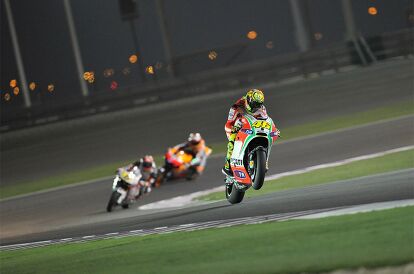





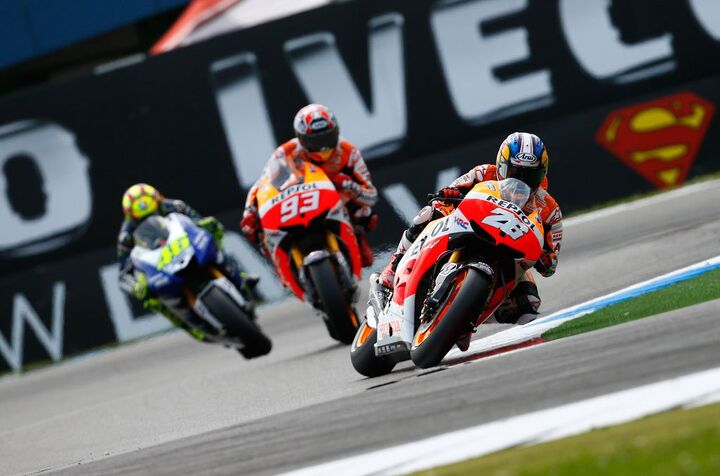








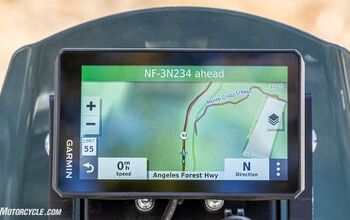






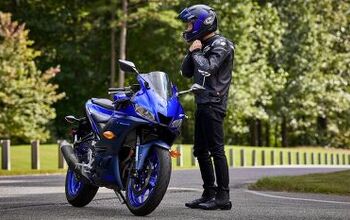






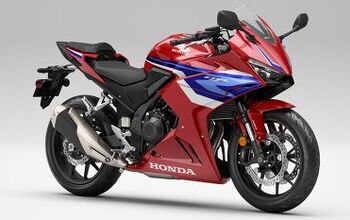


Comments
Join the conversation
Amazing. It's actually being shown in tiny little New York City. Sold out of course.